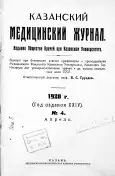Kafka paraffin reaction in cerebrospinal fluid
- Authors: Hodos H.G.1, Gorev N.N.1
-
Affiliations:
- Irkutsk State University
- Issue: Vol 24, No 4 (1928)
- Pages: 450-456
- Section: Articles
- URL: https://bakhtiniada.ru/kazanmedj/article/view/90328
- DOI: https://doi.org/10.17816/kazmj90328
- ID: 90328
Cite item
Full Text
Abstract
Colloids, first applied to study cerebrospinal fluid in 1912 by Lange, have taken a firm place in diagnostics in the form of so-called colloidal reactions. These reactions, as it is known, consist in that artificially prepared colloidal solution is mixed with cerebrospinal fluid in various quantitative ratios, and the reagent undergoes characteristic changes, which can be recorded in the form of curves. Many colloidal reactions have been proposed, but the most common of these are Lange's Goldsol- reaktion, where a colloidal solution of gold is the reagent, and Emanuel's Mastic Reaction. In the relatively short time of their existence, these reactions have generated a huge literature, which is overtaken, on the one hand, by the increased interest of modern neurological clinics in cerebrospinal fluid, on the other hand, by the value of the results of colloid reactions, which often provide an opportunity to make a more accurate and differentiated diagnosis of liquor than it has been possible so far.
Keywords
Full Text
##article.viewOnOriginalSite##About the authors
H. G. Hodos
Irkutsk State University
Author for correspondence.
Email: info@eco-vector.com
Russian Federation
N. N. Gorev
Irkutsk State University
Email: info@eco-vector.com
Russian Federation
References
Supplementary files










